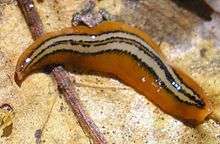Cratera (genus)
| Cratera | |
|---|---|
 | |
| Cratera pseudovaginuloides | |
| Scientific classification | |
| Kingdom: | Animalia |
| Phylum: | Platyhelminthes |
| Class: | Rhabditophora |
| Order: | Tricladida |
| Suborder: | Continenticola |
| Family: | Geoplanidae |
| Subfamily: | Geoplaninae |
| Genus: | Cratera Carbayo et al., 2013 |
| Type species | |
| Geoplana pseudovaginuloides Riester, 1938 | |
Cratera is a genus of land planarians from South America.
Description

The genus Cratera is characterized by having a leaf-shaped body. Most species are between 3 and 7 cm long. The hundreds of eyes distributed along the body are monolobulated, i.e., simple and circular. The copulatory apparatus has a permanent conical penis occupying the entire male cavity. The final portion of the ejaculatory duct, the channel that guides sperm through the penis, has an expanded cavity that resembles a volcanic crater. It is very similar to the related genus Obama, the main difference being the presence of trilobulated eyes in the latter.[1]
Etymology
The name Cratera is derived from the Latin word crater and refers to the cavity in the penis that resembles a volcanic crater.
Species
There are 13 species assigned to the genus Cratera:
- Cratera anamariae Carbayo & Almeida, 2015
- Cratera aureomaculata Rossi & Leal-Zanchet, 2017[2]
- Cratera crioula (E. M. Froehlich, 1955)
- Cratera cryptolineata Rossi & Leal-Zanchet, 2017[2]
- Cratera cuarassu Carbayo & Almeida, 2015
- Cratera joia (Froehlich, 1956)
- Cratera nigrimarginata Rossi & Leal-Zanchet, 2017[2]
- Cratera ochra Rossi, Amaral, Ribeiro, Cauduro, Fick, Valiati & Leal-Zanchet, 2015
- Cratera pseudovaginuloides (Riester, 1938)
- Cratera steffeni Rossi, Fontoura, Amaral & Leal-Zanchet, 2014
- Cratera tamoia (E. M. Froehlich, 1955)
- Cratera viridimaculata Negrete & Brusa, 2016[3]
- Cratera yara (E. M. Froehlich, 1955)
References
- ↑ Carbayo, F.; Álvarez-Presas, M.; Olivares, C. U. T.; Marques, F. P. L.; Froehlich, E. X. M.; Riutort, M. (2013). "Molecular phylogeny of Geoplaninae (Platyhelminthes) challenges current classification: Proposal of taxonomic actions". Zoologica Scripta. 42 (5): 508–528. doi:10.1111/zsc.12019.
- 1 2 3 Rossi, Ilana; Leal-Zanchet, Ana (2017). "Three new species of Cratera Carbayo et al., 2013 from Araucaria forests with a key to species of the genus (Platyhelminthes, Continenticola)". ZooKeys. 643: 1–32. ISSN 1313-2970. doi:10.3897/zookeys.643.11093.
- ↑ Negrete, Lisandro; Brusa, Francisco (2016). "First report of the genus Cratera (Platyhelminthes, Geoplanidae) in Argentina, with description of a new species and comments on the species of the genus". ZooKeys. 610: 1–12. ISSN 1313-2970. PMC 4992809
 . PMID 27587974. doi:10.3897/zookeys.610.9465.
. PMID 27587974. doi:10.3897/zookeys.610.9465.